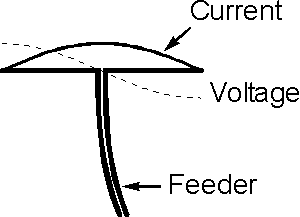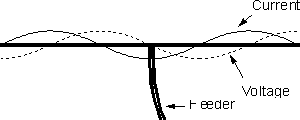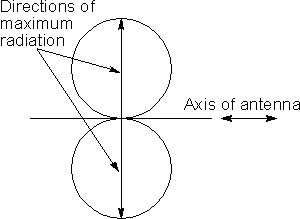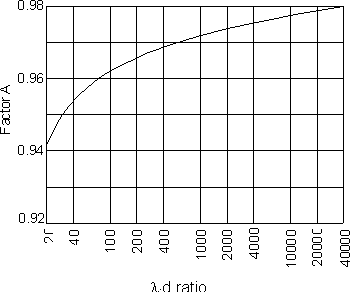The dipole antenna
- overview, summary, tutorial about the basics of the dipole antenna or
dipole aerial that is widely used on its own and as the basis for other RF
antenna designs.
The dipole antenna or dipole aerial is one of the most
important and commonly used types of RF antenna. It is widely used on its own,
and it is also incorporated into many other RF antenna designs where it forms
the radiating or driven element for the antenna.
Basic facts dipole antenna
As the name suggests the dipole antenna consists of two
terminals or "poles" into which radio frequency current flows. This current and
the associated voltage causes and electromagnetic or radio signal to be
radiated. Being more specific, a dipole is generally taken to be an antenna that
consists of a resonant length of conductor cut to enable it to be connected to
the feeder. For resonance the conductor is an odd number of half wavelengths
long. In most cases a single half wavelength is used, although three, five, �.
wavelength antennas are equally valid.

The basic half wave dipole antenna
The current distribution along a dipole is roughly
sinusoidal. It falls to zero at the end and is at a maximum in the middle.
Conversely the voltage is low at the middle and rises to a maximum at the ends.
It is generally fed at the centre, at the point where the current is at a
maximum and the voltage a minimum. This provides a low impedance feed point
which is convenient to handle. High voltage feed points are far less convenient
and more difficult to use.
When multiple half wavelength dipoles are used, they are
similarly normally fed in the centre. Here again the voltage is at a minimum and
the current at a maximum. Theoretically any of the current maximum nodes could
be used.

Three half wavelength wave dipole antenna
Feed impedance
As with any RF antenna, the feed impedance of a dipole
antenna is dependent upon a variety of factors including the length, the feed
position, the environment and the like. A half wave centre fed dipole antenna in
free space has an impedance 73.13 ohms making it ideal to feed with 75 ohm
feeder.
The feed impedance of a dipole can be changed by a variety of
factors, the proximity of other objects having a marked effect. The ground has a
major effect. If the dipole antenna forms the radiating element for a more
complicated form of RF antenna, then elements of the RF antenna will have an
effect. Often the effect is to lower the impedance, and when used in some
antennas the feed impedance of the dipole element may fall to ten ohms or less,
and methods need to be used to ensure a good match is maintained with the
feeder.
Polar diagram
The polar diagram of a half wave dipole antenna that the
direction of maximum sensitivity or radiation is at right angles to the axis of
the RF antenna. The radiation falls to zero along the axis of the RF antenna as
might be expected.

Polar diagram of a half wave dipole in free space
If the length of the dipole antenna is changed then the radiation pattern is
altered. As the length of the antenna is extended it can be seen that the
familiar figure of eight pattern changes to give main lobes and a few side
lobes. The main lobes move progressively towards the axis of the antenna as the
length increases.
Antenna length
The length of a dipole is the main determining factor for the
operating frequency of the dipole antenna. Although the antenna may be an
electrical half wavelength, or multiple of half wavelengths, it is not exactly
the same length as the wavelength for a signal travelling in free space. There
are a number of reasons for this and it means that an antenna will be slightly
shorter than the length calculated for a wave travelling in free space.
For a half wave dipole the length for a wave travelling in
free space is calculated and this is multiplied by a factor "A". Typically it is
between 0.96 and 0.98 and is mainly dependent upon the ratio of the length of
the antenna to the thickness of the wire or tube used as the element. Its value
can be approximated from the graph:

Multiplication factor "A" used for calculating the
length of a dipole
In order to calculate the length of a half wave dipole the
simple formulae given below can be used:
Length (metres) = 150 x A / frequency in MHz
Length (inches) = 5905 x A / frequency in MHz
Using these formulae it is possible to calculate the length
of a half wave dipole. Even though calculated lengths are normally quite
repeatable it is always best to make any prototype antenna slightly longer than
the calculations might indicate. This needs to be done because changes in the
thickness of wire being used etc may alter the length slightly and it is better
to make it slightly too long than too short so that it can be trimmed so that it
resonates on the right frequency. It is best to trim the antenna length in small
steps because the wire or tube cannot be replaced very easily once it has been
removed.
Summary
The dipole antenna is a particualrly important form of RF
antenna which is very widely used for radio transmitting and receiving
applications. The dipole is often used on its own as an RF antenna, but it also
forms the essential element in many other types of RF antenna. As such it is the
possibly the most important form of RF antenna.
|

